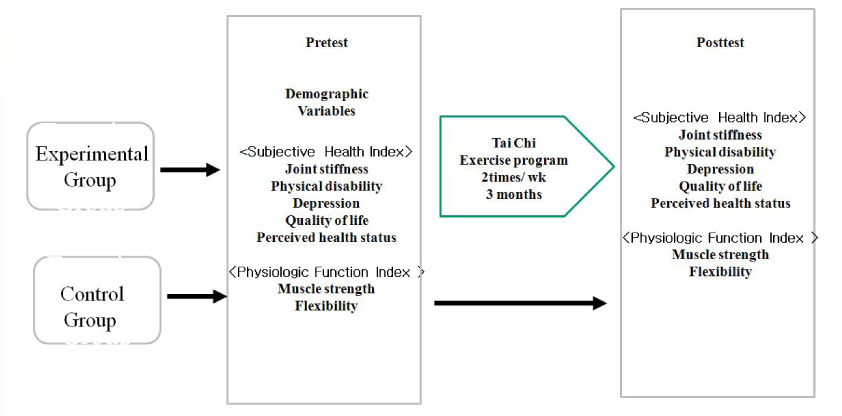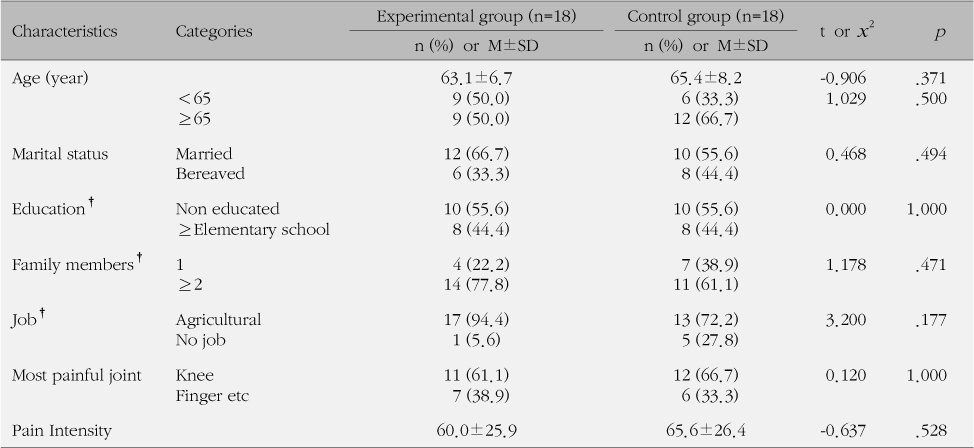Articles
- Page Path
- HOME > J Korean Acad Community Health Nurs > Volume 21(1); 2010 > Article
-
Original Article
- The Effects of a Tai Chi Exercise Program for Patients with Arthritis in Rural Areas
- Aeyoung So, Kyung-Sook Lee, Jung Sook Choi, Eun Hee Lee
-
Journal of Korean Academy of Community Health Nursing 2014;21(1):118-127.
DOI: https://doi.org/10.12799/jkachn.2010.21.1.118
Published online: April 4, 2014
Professor, Department of Nursing, Gangneung-Wonju National University, Korea.
• Received: October 28, 2009 • Revised: March 11, 2010 • Accepted: March 15, 2010
© 2010 Korean Academy of Community Health Nursing
This is an Open Access article distributed under the terms of the Creative Commons Attribution Non-Commercial License (http://creativecommons.org/licenses/by-nc/3.0/) which permits unrestricted non-commercial use, distribution, and reproduction in any medium, provided the original work is properly cited.
- 703 Views
- 0 Download
- 3 Crossref
Abstract
-
Purpose
- The purpose of this study was to evaluate the effects of a Tai-Chi exercise program on subjective health and physiological function index.
-
Methods
- This study was designed as non-equivalent control group pretest-posttest research. Eighteen women in each group completed the posttest with an attendance rate of 78.3 % after 12 weeks. The Tai Chi exercise program was provided two times a week over three months for the experimental group, but no program for the control group. A questionnaire was used for subjective health index, which consisted of Korean-WOMAC Index for joint stiffness, K-HAQ for physical disability, EQ-5D for quality of life and perceived health status, and CES-D for depression. To measure the effect on the physiological function index, femoral muscle strength, shoulder joint and back flexibility were measured.
-
Results
- All variables except left anterior femoral muscle strength had significant homogeneity between the two groups. There were statistically significant differences between the experimental group and the control group in joint stiffness (t=-2.165, p=.03), physical disability (t=-2.231, p=.038), EQ-5D index (t=3.783, p=.001), perceived health status (t=-2.349, p=.025) and femoral posterior muscle strength (t=2.487, p=.038).
-
Conclusion
- The Tai-Chi exercise program was beneficial for women with arthritis in rural communities.
- 1. Bae SC, Cook EF, Kim SY. Psychometric evaluation of a Korean Health Assessment Questionnaire (KHAQ) for clinical research. Rheumatology. 1997;25(10):1975–1979.
- 2. Bae SC, Lee HS, Yun HR, Kim TH, Yoo DH, Kim SY. Cross-cultural adaptation and validation of Korean Western Ontario and McMaster Universities (WOMAC) and sequence osteoarthritis indices for clinical research. Osteoarthritis Cartilage. 2001;9:746–750.
- 3. Baek MH. A study on effects of Tai-Chi exercise program on pain, flexibility, perceived health status, and instrumental activities of daily living for osteoarthritis patients. J Rheumatol Health. 2005;12(2):119–131.
- 4. Chang KO. Effect of Tai Chi exercise program on muscle strength, grip strength, flexibility, pain, depression and self-efficacy in patients with osteoarthritis. J Muscle Joint Health. 2008;15(2):130–139.
- 5. Cho KS, Kang HS, Kim JI, Bak WS, Song RY, Ahn YH, et al. Comparing effects of Tai Chi exercise, Tai Chi self-help program, and self-help management program for osteoarthritis patients. J Muscle Joint Health. 2007;14(1):77–85.
- 6. Cho YS, Kim MH, Uhm WS, Kim SH. Crosscultural adaptation and validation of the Korean Version of EQ-5D in patients with rheumatic diseases. J Korean Rheum Assoc. 2005;12(3):173–188.
- 7. Choi JH, Lee EO, Lee HY, Eun Y. Analysis of the effect of Tai Chi on muscle strength and flexibility. J Rheumatol Health. 2005;12(1):69–80.
- 8. Choi JH, Moon JS, Song KE. The effects of Tai Chi exercise on physiologic, psychological functions, and falls among fall-prone elderly. J Rheumatol Health. 2003;10(1):62–76.
- 9. Choi JS, So AY, Lee EH, Lee KS. Effects of self-help Tai Chi for arthritis applying the nine movement Tai Chi. J Muscle Joint Health. 2008;15(1):62–72.
- 10. Cohen J. Statistical power analysis for the behavioral sciences. 2nd ed. NJ: Lawrence Erlbaum Associates Inc; 1998.
- 11. Chon KK, Rhee MK. Preliminary Development of Korean Version of CES-D. Korean J Clin Psychol. 1992;11(1):65–76.
- 12. Han MA, Ryu SY, Park J, Kang MG, Park JK, Kim KS. Health-related quality of life assessment by the EuroQol-5D in some rural adults. J Prev Med Public Health. 2008;41(3):173–180. Article
- 13. Hong SY, Kim KH, Gwan JH, Hwang RH, Tae YH. Effectiveness of elderly exercises services for health promotion. Seoul: National Health Insurance Corporation; 2007.
- 14. KCDC (The Korea Centers for Disease Control and Prevention) & KIHASA (Korea Institute for Health and Social Affairs). In-depth analysis of the third national and nutrition examination survey: The health interview and behavior survey part. Seoul: KCDC (The Korea Centers for Disease Control and Prevention) & KIHASA (Korea Institute for Health and Social Affairs); 2007.
- 15. Kim EY, So AY. The effect of community-based self-help management program for patients with diabetes mellitus. J Korean Acad Community Health Nurs. 2009;20(3):307–315.
- 16. Kim JI, Kang HS, Bae SC, Lee EO. Exercise pattern and influencing factor of exercise barrier in patients with osteoarthritis. J Rheumatol Health. 2002;9(2):135–153.
- 17. Korean Society of Muscle & Joint Health. TCA 1 instructor's handbook. Seoul: Korean Society of Muscle & Joint Health; 2005.
- 18. Lee HY. Comparison of effects among Tai-Chi exercise, aquatic exercise, and a self-help program for patients with knee osteoarthritis. J Korean Acad Nurs. 2006;36(3):571–580. ArticlePDF
- 19. Lee HY, Lee KJ. Effects of Tai Chi exercise in elderly with knee osteoarthritis. J Korean Acad Nurs. 2008;38(1):11–18. Article
- 20. Lee YH, Choi JS, Rhee JA, Ryu SY, Shin MH, Kim JH. A study on the application of the Korean validation weights for EuroQol-5 dimension. J Korean Soc Health Educ Promot. 2009;26(1):1–13.
- 21. Li F, Fisher KJ, Harmer P, McAuley E. Delineating the impact of Tai Chi training on physical function among the elderly. Am J Prev Med. 2002;23(2):Suppl 192–97. Article
- 22. Lorig K, Sobel D, Gonzalez V, Minor M. Living a healthy life with chronic conditions (3). CA: Bull Publishing Company; 2006.
- 23. MOHW & KIHASA (Ministry of Health and Welfare, Korea Institute for Health and Social Affairs). The Third National Health and Nutrition Examination Survey (KNHANES ), 2005. III -Illness of adults-. Seoul: MOHW & KIHASA (Ministry of Health and Welfare, Korea Institute for Health and Social Affairs); 2006-a.
- 24. MOHW & KIHASA (Ministry of Health and Welfare, Korea Institute for Health and Social Affairs). The Third National Health and Nutrition Examination Survey (KNHANES III), 2005. -Activity limitation and health-related quality of life-. Seoul: MOHW & KIHASA (Ministry of Health and Welfare, Korea Institute for Health and Social Affairs); 2006-b.
- 25. Nam HS, Kim KY, Kwon SS, Ko KW, Kind P, Yang HK, et al. EQ-5D Korean valuation study using time trade off method. Daejeon: Chungnam National University; 2007.
- 26. So AY. Expansion strategy of Wonju healthy city project to rural area In: Paper presented at the meeting of the Healthy City Wonju Forum Workshop; Wonju: 2005.
- 27. Song RY, Lee EO, Lam P, Bae SC. Effects of Tai Chi exercise on pain, balance, muscle strength, and physical functioning in older women with osteoarthritis: A randomized clinical trial. J Rheumatol. 2003;30(9):2039–2044.
- 28. Tak E, Staat P, Van Hespen A, Hopman-Rok M. The effects of an exercise program for older adults with osteoarthritis of the hip. J Rheumatol. 2005;32(6):1106–1113.
- 29. Yoon TH, Kim JH. Health inequalities between rural and urban areas in South Korea. J Korean Acad Rural Health Nurs. 2006;1(1):11–20.
- 30. Yun JH, Kang JM, Kim KS, Kim SH, Kim TH, Park YW, et al. Health-related quality of life in Korean patients with chronic diseases. J Korean Rheum Assoc. 2004;11(3):263–274.
Figure & Data
References
Citations
Citations to this article as recorded by 

- The Effects of a Pilates Exercise Program using Self-Efficacy Sources in Elderly Women
Choon-Ji Lee, Yeon-Hee Choi
Journal of Environmental Science International.2015; 24(1): 117. CrossRef - Effect of Program Promoting Intention to Exercise Performance Based Theory of Planned Behavior in the Elderly
Jin-Soon Kim, Hye-Jin Hyun
Journal of Korean Biological Nursing Science.2015; 17(1): 1. CrossRef - The Effect of Exercise Program on Pain and Quality of Life for Patients with Knee Osteoarthritis: A Systematic Review and Meta-Analysis
Cheonggu Yun, Changsik An
Journal of muscle and joint health.2014; 21(3): 173. CrossRef

 KACHN
KACHN




 PubReader
PubReader Cite
Cite


